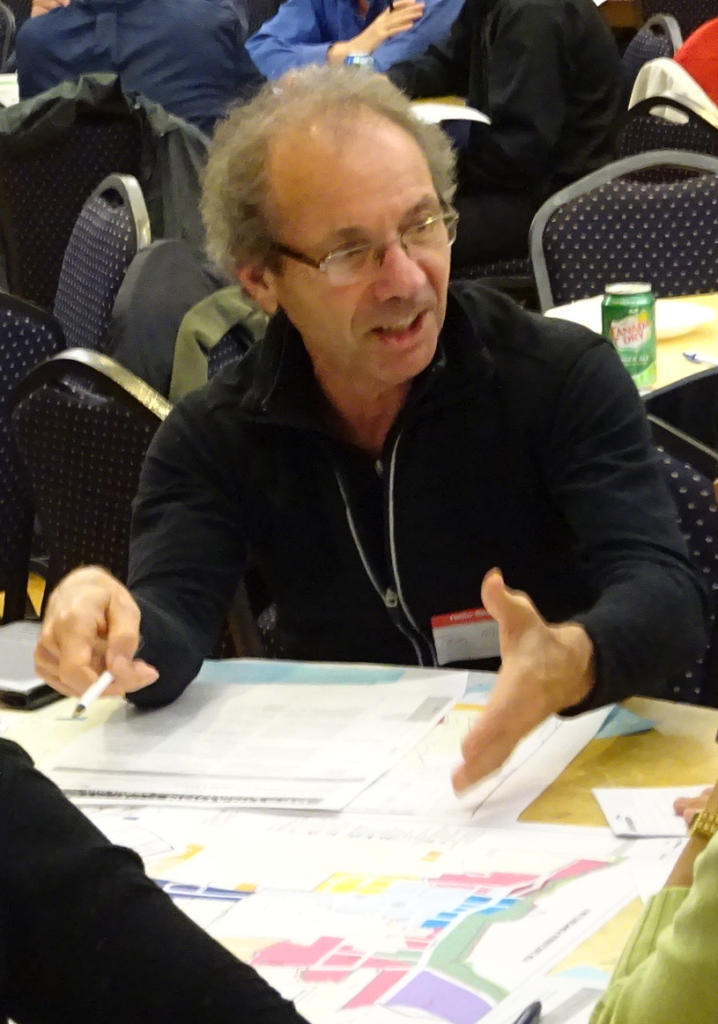 By Pepper Parr
By Pepper Parr
December 8th, 2017
BURLINGTON, ON
Tom Muir was leaving city hall recently, heading to the parking lot and crossed paths with city manager James Ridge.
A conversation ensued. Muir describes his conversation with Ridge as “cordial”

Tom Muir making a point
Muir mentioned the verbal scuffle he had with Councillor Taylor over what Muir thought were points Taylor didn’t want to hear; that the city was using concepts that were not vetted and not approved on the 421 Brant project that was approved by the planning department and then passed by city council under the current Official Plan.
The city is in the process of writing a totally new Official Plan and was pushing very hard to get it done before the end of the year. The public began to push back even harder and the completion date for the new Official Plan, now in draft form is now uncertain.

James Ridge at his first city council meeting.
Muir says that Ridge immediately disagreed and asserted that it was a “negotiation”. Carriage Gate, the developer, had the right to build a 12 storey structure on the property they had assembled.
It has been described as an ugly squat building that used every square foot available. No one liked the look of the building but it was what the developer was allowed to do.
The city apparently came back with the tall building guidelines that call for podiums that were set back nicely from the property line, rose to four storeys and then had a tall skinny building that rose an additional 19 storeys.
The revised proposal Carriage Gate took to the planning department was for 27 storeys – the planners recommended 23 and that was what council bought on a 5-2 vote with the Mayor and Meed Ward dissenting..
Ridge said, according to Muir, that this is what was “negotiated”.

Tom Muir, a frequent delegator at city hall.
Muir said this was arbitrary and gave everyone around that table power they are not supposed to have if Official Plans and zoning bylaws that the public has bought into are to mean anything at all. Why have bylaws and height/density limits if the parties can just negotiate them away was Muir’s argument.
Muir said Ridge didn’t have a real answer, except he called that “good planning”, and added that he and Ridge talked about the economics, and the built form. They chose high and skinnier rather than shorter, squat, not the massing city wanted, and perhaps butt ugly, like the Sims building which Muir adds was his example not Ridge’s.
Muir’s view is this might be central to any OMB appeal case. Is it “good planning” to just ignore the determinative Official Plan and zoning bylaws and public opinion that gets expressed at required meetings that go way out of compliance and are rationalized as “negotiation”, when they appear to be no more than arbitrary decisions.

James Ridge Burlington city manager.
Muir said Ridge maintained that the existing Official Plan was designed to be “a negotiation” framework,
In my view, says Muir, this introduces arbitrary power to rules that are supposed to be complied with so that arbitrary is not in the cards to enable noncompliance. “That’s a door to corruption, like it or not.”
Muir makes an additional point.
What Carnicelli didn’t say in his delegation was that Carriage Gate began assembling property for this project ten years ago and that they at one point took a proposal to the Planning department that met the 12 storey limit many people want.
It was a pretty plain looking building that used every possible foot of the property – not much in the way of a street-scape – but it met the rules.
The developer and the Planning department worked together to come up with the structure that met the tall building guide lines that were new and the developer revised the proposal.
City council decided it was what the city needed and voted for it; with two exceptions, the Mayor and Councillor for the ward.
Now, as a citizen, ask yourself this; would you rather have an 11-storey mass (I believe this is the ugly that Mr. Ridge is referring to) or a 23-storey building, 19 storeys in a slender tower? Consider that the 11-storey building is at the property lines and the tall building is set back (wider sidewalks) and the bulk of the tall building is set back once you pass the podium.
Why are we beating up the developer?
The City has never seen anything like this!



















All valid comments. However instead of concentrating efforts on stopping/delaying the process (costs money) the Council should perhaps bring the community on board in the preparation of the OP, that has a clear ‘Vision” of what we are talking about. I was shocked when I saw an ugly tall building squatting on the sidewalk outside City Hall, so became motivated enough to attend my first meeting as an observer. Then I heard that the the planning department had intact already advanced quite a bite towards reaching agreement on a well designed podium, setbacks, taller tower setback further. If there had been shuck a public discussion in advance, perhaps with an idea of how this approach can totally transform and enhance the future quality of the built environment along Brant Street for the pedestrian user and store owners, there may have been wider support from the public. People , not cars, are the patrons of businesses. The detail at street level (civic design) is what make people head to one destination vs another. Smooth pavements, Trees, benches, litter boxes, street signs geared to pedestrians, and many more. These conversations will provide the basis for defining “Values” that the residents share in common. Developers and their architects will then not waste time playing the ‘crap-game’ of asking much more and settling of a bit less. The losers are always the residents.
The developer had the “right” to develop 12 storeys on one of the properties; the others were zoned 4. The wider sidewalk is possible at 12 storeys through parkland dedication.
Rather than answering the false choice question of height versus aesthetics, other more relevant questions are important:
– why does the city want to change the OP to give away height and density, while getting nothing in return? We’ll meet our 2031 growth targets in the next couple of years.
-why do we want to turn Burlington’s downtown into Toronto’s City Place; a soullessly named area for a desolate collection of slender, unattractive towers on podiums?
– why would we listen to the design sensibilities of bureaucrats whose recent brute design additions to our local parks, plus the placement of art on median strips should tell us everything they know?
– what makes bureaucrats the authority on land economics when their specialization is the writing and administering of policies and procedures, control by policy and functional specialization?
-Given their out-of-their depth opinions on land economics, should we not be concerned with unintended consequences of their decisions on land speculation?
William,
I like your point of view, expressed here numerous times. You always fill in some blanks others of us miss.
All these questions warrant thought and answers, although I don’t think city will provide them.
Besides, the appropriate answers appear self evident.
My main concern is traffic problems. Haven’t we got enough headaches now with Burlington traffic problems without adding a huge amount more?
In my mind, this whole exercise begs the question – could the developer have deliberately brought an ugly 12-story building plan to the city, knowing they would reject it and have to begin a negotiation to get something better? Then lo and behold a better plan is submitted but at over twice the height, to which the city can only seem to say “ok, but not quite so high”. Maybe the City needs better negotiators in planning?
Good point!
Official Plans and Zoning By-Laws are CONSTRAINTS and not negotiation starting points. If he doesn’t understand or believe that, maybe James Ridge should find another municipality to work for.
I thought the developer made an application or a 27 storey building. This would mean that the City was required to review that application, not a 12 storey building. What am I missing?
I’m not sure the developer could generate maximum profits from an ugly, blocky building. So this is really a straw-man argument from Ridge. Carriage Gate has a huge incentive to make the building attractive, have maximum orientation to the lake and contain architectural elements that would drive sales, demand and ultimately profit dollars.
I definitely vote tall skinny over short squat no brainer for me
Hey Craig: If you decide to move into one of these tall skinny structures make sure you choose a unit below the 8th floor. Studies have shown that by the time paramedics and firefighters reach you on the 23rd you’ll either be in the afterlife or burnt toast! Also, hope like hell that Council sets aside enough funds in the next municipal budget to provide for higher aerial ladders and additional rescue resources.
Disaster management protocols need to change with higher densities and taller buildings. Oops…something else planners and Council forgot to consider.
I am sorry, but I am having trouble seeing how the writer can brand this is as “beating up the developer”. It occurs to me that engaged citizens are merely asking good questions about the process, about who has authority to make deals, and what if anything do our current and future Official Plans mean, if they can be overridden. I think we want a process that we can depend upon so that we can go back to just enjoying our city, versus having to attend countless meetings, only to be ignored. Let’s not make this about planning, or Carriage Gate or Council, when what it is, is democracy in action, about people speaking up when they believe they are not being heard.
Just to clarify, Mr. Ridge and I discussed the economics and built form, but I myself did not choose higher and skinnier – that is, “we” did not choose thus.
It was Mr. Ridge that described to me his opinion on how tall and skinny arose from his view of the economics and what the building might look like. I understand the logic, but did not choose the outcome in this case.
It was part of his argument that the developer was given about the same square footage in the skinny, as he could have built in the shorter building that was allowed for this site. But this point has a twist in it, not mentioned here.
The key point missing is one a reader made earlier in November, about whether the alternative was 11 stories, which are not subject to the tall building guidelines, or 12 stories, which are. This reader is the author of the last long paragraph in the story.
So on the face of this, the 11 stories within the existing rules is the ugly choice, but only based on deliberate ugly architecture. As a delegate at a related city meeting said, if you can’t design a nice 11 (or even 12) story building, then you need to find a new architect.
My side of the conversation was essentially about “negotiation” giving 23 stories, that is way out of compliance, arbitrary, not transparent publicly with any of the terms of negotiation, based on unapproved, unofficial, not publicly supported proposed planners ideas, and tall building guidelines not subject to public engagement, just endorsed by city.
So the story still reduced in my side of the conversation, to the idea that a 12 story tall building was what was allowed, but the developer got 23, rationalized as “negotiation”. Is there something missing in this picture?
This use of authority and power I found compellingly wrong, assertions on economics, and perceptions of beauty notwithstanding.
How did this happen, who decided, what is the rationale, and more, are open questions.
Obviously, the public outcry, and two nay votes at Council, warrant some serious answers about the span and power of “negotiation”
Are there no limits?
As several delegates pointed out, architects design beautiful 12 storey buildings all over the world. It is not a case of either an ugly 12 storey that sits too close to the sidewalk or else tall and skinny and 20+ storeys. If the city hated the first design then ask for a better one that’s 12 storeys and not boxy and uninspired.
Also this is the same developer who has already changed his original promises on the new development at Caroline and John. So yes, lots of people have concerns about the developer. Agree with Tom Muir that this stinks in many ways and the community is looking at it carefully.
Why is it that every time we have a development proposal put before Council or citizens to consider it is always framed as a dichotomy? Things are either this way or that. We can either have an 11 storey ugly building or a 23 storey attractive one.
What about having an 11 storey architecturally attractive building that isn’t plain and fits within the height requirements of what most citizens want? And while we’re at it, who says the 19, 23 and 27 storey buildings are attractive…other of course than the developers and their friend Mr. Ridge? Architecture, like art, is in the eye of the beholder.
More to the point of the article…why have an Official Plan and zoning by-laws if, in the final analysis, everything is negotiable?
If Tom’s interactions prove one thing it is to show what an utter mockery and joke discussions around the Official Plan and the Mobility Hubs have become. James Ridge and Mary Lou Tanner have clearly lost control of the process, and credibility and public trust have been eclipsed.